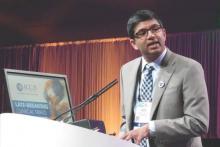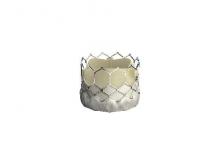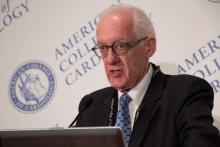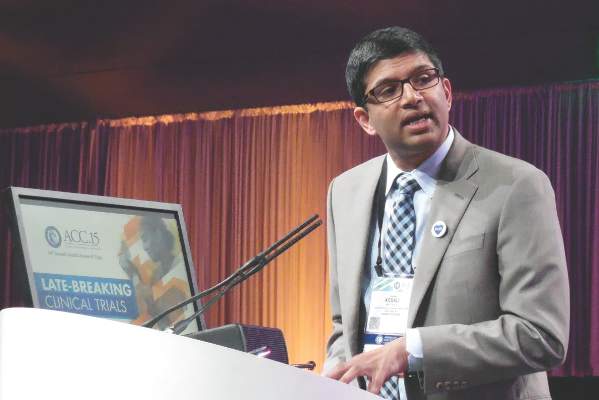User login
SAN DIEGO – Three separate reports of pivotal trial results from three different systems for performing transcatheter aortic valve replacement performed during three distinct periods highlighted the rapid advances of this intervention that have now put it on the cusp of being the preferred, default strategy for replacing stenosed aortic valves in older patients.
First SAPIEN 3 U.S. outcomes reported
The most recent technologic advance in transcatheter aortic valve replacement (TAVR), showcased in one of the three presentations at the annual meeting of the American College of Cardiology, was the SAPIEN 3 System, the lowest-profile TAVR system so far to undergo U.S. testing with a 14F delivery system for all valve sizes except the largest, 29 mm valves, which require a 16F system. SAPIEN 3 produced 30-day outcome results so good that one TAVR operator expressed shock at the dramatic, short-term success.
After 30 days follow-up, SAPIEN 3 produced a 2% mortality rate and a 2% stroke rate in 583 “high-risk” patients treated during 2013 and 2014 who were an average of 83 years old and had an average Society of Thoracic Surgeons (STS) risk score of 8.6%, Dr. Susheel K. Kodali reported at the meeting. By contrast, in the pivotal trial of the first-generation SAPIEN TAVR system, run during 2007-2009, in 348 “high-risk” patients (who averaged 84 years old and had an average STS risk score of 11.8%) the 30-day mortality ran 5% and 30-day strokes affected 6%, Dr. Kodali noted.
The new trial also enrolled 1,076 “intermediate”-risk patients, who averaged 82 years old with an average STS score of 5.3%. Their 30-day mortality rate was 1% and their total stroke rate was 3%, with a disabling stroke rate (modified Rankin scale score of 2 or more) of 1%.
These excellent results prompted Edwards, the company developing the SAPIEN 3 System, to apply for Food and Drug Administration approval for the device in high-risk patients, Dr. Kodali noted. In March, Edwards released a statement in which it said it expects SAPIEN 3 to receive U.S. marketing approval within a year. While Dr. Kodali said longer-term follow-up is needed for the intermediate-risk patients, the outcome results he has seen make him rethink the TAVR’s role, compared with conventional aortic valve replacement by open surgery.
“With surgery, these [intermediate-risk] patients would have a 5% mortality rate. The conversation now may need to change,” he said. “We have always said we use TAVR when surgery is not a good option, but based on the recent, 2-year findings with the CoreValve and our data, with a 1% mortality and a 1% disabling stroke rate [in intermediate-risk patients] maybe TAVR is now the preferred option, at least for 80-year-olds, said Dr. Kodali, codirector of the Heart Valve Center at NewYork-Presbyterian/Columbia University Medical Center.
Commenting on the SAPIEN 3 results as well as excellent 2-year results from the CoreValve TAVR System pivotal trial, Dr. Jeffrey J. Popma attributed the success to three factors: improved patient selection, refined and routinely used imaging methods for sizing the aortic annulus to better match the TAVR valve size to the annulus size, and improved TAVR techniques based on what is now about an 8-year clinical experience using TAVR.
“All this now puts us in a place where the bar has been set very high for surgery. How does surgery compete?” asked Dr. Popma, professor of medicine at Harvard University and an interventional cardiologist at Beth Israel Deaconess Medical Center in Boston. “The results are so clean at 30 days, what more information do we really need” for device approval? Dr. Popma, one of the discussants for the meeting report by Dr. Kodali, asked.
“I’m shocked the SAPIEN 3 data were so good,” said Dr. Stephen Ramee, an interventional cardiologist and medical director of the Structural and Valvular Heart Center at the Ochsner Medical Center in New Orleans. “We’ll need to wait to do intermediate-risk patients routinely, but the handwriting is on the wall with these data and the CoreValve results. I think TAVR will be preferred for all high-risk patients and for intermediate-risk patients who are at least 80 years old,” Dr. Ramee said in an interview.
Commenting on whether the FDA should approve SAPIEN 3 based on 30-day outcomes in high-risk patients, Dr. Popma noted that SAPIEN 3 is “an iteration of what has been demonstrated” in long-term results with the first-generation SAPIEN device. “Do we really need a randomized clinical trail with several thousand patients after the [SAPIEN] platform was already established?” he asked.
“We don’t demand that for iterations of surgical valves,” agreed Dr. Kodali.
CoreValve looks good longer-term
While SAPIEN 3’s performance turned heads, 2-year results from the CoreValve’s pivotal trial reported at the meeting further deepened the impression that TAVR offered substantial advantages, compared with surgical aortic valve replacement in high-risk patients. The 2-year outcomes followed the trial’s primary endpoint reported last year, the 1-year results, which had shown a statistically significant advantage in survival, compared with surgery (N. Engl. J. Med. 2014;370:1790-8).
The 2-year follow-up showed this advantage was “sustainable, durable, and widening,” reported Dr. Michael Reardon, professor of cardiothoracic surgery at the Methodist Hospital in Houston.
For example, 2-year all-cause mortality stood at 29% in patients who underwent surgical valve replacement and 22% in those who received TAVR with CoreValve, a statistically significant widening of the between-group gap, compared with the respective 19% and 14% mortality rates after 1 year. The rate of all-cause death or major stroke after 2 years ran 33% and 24% with surgical valve replacement or TAVR, respectively, compared with rates of 23% and 16% after 1 year.
Concern about excess strokes with TAVR, “one of our early worries, seems to have been put to bed,” Dr. Reardon said. The results also showed CoreValve substantially surpassed open surgery for valvular blood flow metrics across the full range of follow-up time points.
Several factors might have produced the widening outcomes between years 1 and 2 following a different one-time intervention, Dr. Reardon said, such as significant differences in the incident rate following intervention for disabling or life-threatening bleeding, atrial fibrillation, and acute kidney injury. All three complications occurred significantly more often in the surgery patients, compared with those treated with TAVR, and while the bulk of the difference in incidence showed up within the first month after intervention, each of these complications could have important long-term effects on survival and stroke rates, Dr. Reardon explained. On the other side of the ledger, open surgery when compared with CoreValve resulted in significantly fewer acute and long-term episodes of vascular complications and fewer new pacemakers, but these complications likely have less impact on stroke and mortality than the three that occur more often with surgery.
Overall, the widening gap in outcomes between surgery and TAVR “suggests that TAVR with a self-expanding valve [CoreValve] should be considered the preferred treatment,” compared with surgery in high-risk patients, Dr. Reardon said during his presentation at the meeting, a similar conclusion to what Dr. Kodali said about SAPIEN 3.
“These results really do move the needle forward,” said Dr. Popma, a CoreValve trial coinvestigator. “We see for the first time that [TAVR] may indeed be superior, and although durability remains a long-term question we have 2-year data that CoreValve has held up.”
First-generation SAPIEN TAVR shows 5-year stability
The third piece of the TAVR trilogy reported at the meeting was 5-year follow-up results from the first U.S. TAVR pivotal trial (PARTNER 1) using the first-generation SAPIEN device, which is no longer available in the United States. Those results from patients treated during 2007-2009 showed continuation of the statistical overlap between surgical valve replacement and SAPIEN TAVR for all-cause mortality, stroke, and other outcomes (Lancet 2015 [doi:10.1016/S0140-6736(15)60290-2]). Importantly, the results also showed no suggestions of deteriorating function in the TAVR valve after 5 years, reported Dr. Michael J. Mack at the meeting.
“It’s very encouraging, but we’d all like to go out to 10-12 years, and then we’d feel a lot better about it,” commented Dr. Reardon, who did not participate in the PARTNER trial. But given 5 years of apparently reliable function from a TAVR valve, the issue of long-term durability of these valves, an open question at the start of the SAPIEN trial, may be now coming to resolution, he suggested, at least for octogenarians, who are emerging as the prime demographic for TAVR.
“Tissue valves we place surgically deteriorate at different rates depending on a patient’s age when you put them in. In 30-year-olds many valves deteriorate after 10 years; in 50-year-olds maybe 15% will deteriorate, and in 70-year-olds almost none,” Dr. Reardon explained. “No one knows why.” Because many TAVR patients are at least 80 years old “it may take 10 years to see a signal of deterioration, or we might never see a signal,” he said.
SAPIEN versus CoreValve?
Although SAPIEN 3 may be on the U.S. market within the next year, for the time being routine U.S. TAVR practice is limited to two options, approved for high-risk or inoperable patients but not patients at intermediate risk: the CoreValve, which has now clearly bested surgery for all major endpoints over at least the midterm, and the SAPIEN XT model, the second-generation SAPIEN TAVR system that sits between the first generation and SAPIEN 3 and showed documented performance that roughly tracked with the original SAPIEN model. When approving the SAPIEN XT for U.S. marketing in June 2014 for operable high-risk patients as well as inoperable patients, the agency said the evidence indicated that XT was “noninferior” to SAPIEN in high-risk patients.
Several experts at the meeting agreed that despite this difference in performance between CoreValve and SAPIEN XT when each was compared with open surgery, the CoreValve experience better reflected more contemporary performance expectations for TAVR as a class, regardless of device. They cited improvements in valve sizing with imaging, better patient selection, and better TAVR technique as critical in boosting more favorable outcomes, factors that are not valve specific.
They also cited technical factors that may favor the SAPIEN XT device, notably more accurate valve placement using SAPIEN’s balloon-expandable format, compared with the self-expanding CoreValve.
Dr. Ramee said that outside of trials he’s now using SAPIEN XT for about 60% of his cases because of its “more predictable deployment. With CoreValve, you never know exactly where it will end up.” On the other hand, CoreValve works best for a more calcified aortic annulus because self-expanding placement is gentler and less likely to rupture a fragile annulus. That advantage gives CoreValve the edge for about 40% of his patients, Dr. Ramee said in an interview.
“There has been a general forward movement of the TAVR field” in which the focus has been TAVR versus surgery rather than CoreValve versus SAPIEN, Dr. Reardon said in an interview. Some anatomic features favor balloon expandable, others favor self-expanding. New TAVR systems in development by other manufacturers are mostly self-expanding models because of their ability to allow for repositioning, he noted.
Dr. Kodali has an equity interest in Thubrikar Aortic Valve; he has received honoraria from St. Jude; he has served on the steering committee for trials sponsored by Edwards, which markets the SAPIEN systems, Claret Medical, and Meril; and he has received research support from Edwards. Dr. Popma has been a consultant to Abbott, Abiomed, Boston Scientific, Cordis, and Abbott Vascular, and he has received research grants from Medtronic, which markets the CoreValve, and from five other companies. Dr. Reardon has served on an advisory board for Medtronic, Dr. Ramee has received honoraria from Edwards and from Medtronic and has a financial interest in several other companies developing TAVR systems.
On Twitter @mitchelzoler
SAN DIEGO – Three separate reports of pivotal trial results from three different systems for performing transcatheter aortic valve replacement performed during three distinct periods highlighted the rapid advances of this intervention that have now put it on the cusp of being the preferred, default strategy for replacing stenosed aortic valves in older patients.
First SAPIEN 3 U.S. outcomes reported
The most recent technologic advance in transcatheter aortic valve replacement (TAVR), showcased in one of the three presentations at the annual meeting of the American College of Cardiology, was the SAPIEN 3 System, the lowest-profile TAVR system so far to undergo U.S. testing with a 14F delivery system for all valve sizes except the largest, 29 mm valves, which require a 16F system. SAPIEN 3 produced 30-day outcome results so good that one TAVR operator expressed shock at the dramatic, short-term success.
After 30 days follow-up, SAPIEN 3 produced a 2% mortality rate and a 2% stroke rate in 583 “high-risk” patients treated during 2013 and 2014 who were an average of 83 years old and had an average Society of Thoracic Surgeons (STS) risk score of 8.6%, Dr. Susheel K. Kodali reported at the meeting. By contrast, in the pivotal trial of the first-generation SAPIEN TAVR system, run during 2007-2009, in 348 “high-risk” patients (who averaged 84 years old and had an average STS risk score of 11.8%) the 30-day mortality ran 5% and 30-day strokes affected 6%, Dr. Kodali noted.
The new trial also enrolled 1,076 “intermediate”-risk patients, who averaged 82 years old with an average STS score of 5.3%. Their 30-day mortality rate was 1% and their total stroke rate was 3%, with a disabling stroke rate (modified Rankin scale score of 2 or more) of 1%.
These excellent results prompted Edwards, the company developing the SAPIEN 3 System, to apply for Food and Drug Administration approval for the device in high-risk patients, Dr. Kodali noted. In March, Edwards released a statement in which it said it expects SAPIEN 3 to receive U.S. marketing approval within a year. While Dr. Kodali said longer-term follow-up is needed for the intermediate-risk patients, the outcome results he has seen make him rethink the TAVR’s role, compared with conventional aortic valve replacement by open surgery.
“With surgery, these [intermediate-risk] patients would have a 5% mortality rate. The conversation now may need to change,” he said. “We have always said we use TAVR when surgery is not a good option, but based on the recent, 2-year findings with the CoreValve and our data, with a 1% mortality and a 1% disabling stroke rate [in intermediate-risk patients] maybe TAVR is now the preferred option, at least for 80-year-olds, said Dr. Kodali, codirector of the Heart Valve Center at NewYork-Presbyterian/Columbia University Medical Center.
Commenting on the SAPIEN 3 results as well as excellent 2-year results from the CoreValve TAVR System pivotal trial, Dr. Jeffrey J. Popma attributed the success to three factors: improved patient selection, refined and routinely used imaging methods for sizing the aortic annulus to better match the TAVR valve size to the annulus size, and improved TAVR techniques based on what is now about an 8-year clinical experience using TAVR.
“All this now puts us in a place where the bar has been set very high for surgery. How does surgery compete?” asked Dr. Popma, professor of medicine at Harvard University and an interventional cardiologist at Beth Israel Deaconess Medical Center in Boston. “The results are so clean at 30 days, what more information do we really need” for device approval? Dr. Popma, one of the discussants for the meeting report by Dr. Kodali, asked.
“I’m shocked the SAPIEN 3 data were so good,” said Dr. Stephen Ramee, an interventional cardiologist and medical director of the Structural and Valvular Heart Center at the Ochsner Medical Center in New Orleans. “We’ll need to wait to do intermediate-risk patients routinely, but the handwriting is on the wall with these data and the CoreValve results. I think TAVR will be preferred for all high-risk patients and for intermediate-risk patients who are at least 80 years old,” Dr. Ramee said in an interview.
Commenting on whether the FDA should approve SAPIEN 3 based on 30-day outcomes in high-risk patients, Dr. Popma noted that SAPIEN 3 is “an iteration of what has been demonstrated” in long-term results with the first-generation SAPIEN device. “Do we really need a randomized clinical trail with several thousand patients after the [SAPIEN] platform was already established?” he asked.
“We don’t demand that for iterations of surgical valves,” agreed Dr. Kodali.
CoreValve looks good longer-term
While SAPIEN 3’s performance turned heads, 2-year results from the CoreValve’s pivotal trial reported at the meeting further deepened the impression that TAVR offered substantial advantages, compared with surgical aortic valve replacement in high-risk patients. The 2-year outcomes followed the trial’s primary endpoint reported last year, the 1-year results, which had shown a statistically significant advantage in survival, compared with surgery (N. Engl. J. Med. 2014;370:1790-8).
The 2-year follow-up showed this advantage was “sustainable, durable, and widening,” reported Dr. Michael Reardon, professor of cardiothoracic surgery at the Methodist Hospital in Houston.
For example, 2-year all-cause mortality stood at 29% in patients who underwent surgical valve replacement and 22% in those who received TAVR with CoreValve, a statistically significant widening of the between-group gap, compared with the respective 19% and 14% mortality rates after 1 year. The rate of all-cause death or major stroke after 2 years ran 33% and 24% with surgical valve replacement or TAVR, respectively, compared with rates of 23% and 16% after 1 year.
Concern about excess strokes with TAVR, “one of our early worries, seems to have been put to bed,” Dr. Reardon said. The results also showed CoreValve substantially surpassed open surgery for valvular blood flow metrics across the full range of follow-up time points.
Several factors might have produced the widening outcomes between years 1 and 2 following a different one-time intervention, Dr. Reardon said, such as significant differences in the incident rate following intervention for disabling or life-threatening bleeding, atrial fibrillation, and acute kidney injury. All three complications occurred significantly more often in the surgery patients, compared with those treated with TAVR, and while the bulk of the difference in incidence showed up within the first month after intervention, each of these complications could have important long-term effects on survival and stroke rates, Dr. Reardon explained. On the other side of the ledger, open surgery when compared with CoreValve resulted in significantly fewer acute and long-term episodes of vascular complications and fewer new pacemakers, but these complications likely have less impact on stroke and mortality than the three that occur more often with surgery.
Overall, the widening gap in outcomes between surgery and TAVR “suggests that TAVR with a self-expanding valve [CoreValve] should be considered the preferred treatment,” compared with surgery in high-risk patients, Dr. Reardon said during his presentation at the meeting, a similar conclusion to what Dr. Kodali said about SAPIEN 3.
“These results really do move the needle forward,” said Dr. Popma, a CoreValve trial coinvestigator. “We see for the first time that [TAVR] may indeed be superior, and although durability remains a long-term question we have 2-year data that CoreValve has held up.”
First-generation SAPIEN TAVR shows 5-year stability
The third piece of the TAVR trilogy reported at the meeting was 5-year follow-up results from the first U.S. TAVR pivotal trial (PARTNER 1) using the first-generation SAPIEN device, which is no longer available in the United States. Those results from patients treated during 2007-2009 showed continuation of the statistical overlap between surgical valve replacement and SAPIEN TAVR for all-cause mortality, stroke, and other outcomes (Lancet 2015 [doi:10.1016/S0140-6736(15)60290-2]). Importantly, the results also showed no suggestions of deteriorating function in the TAVR valve after 5 years, reported Dr. Michael J. Mack at the meeting.
“It’s very encouraging, but we’d all like to go out to 10-12 years, and then we’d feel a lot better about it,” commented Dr. Reardon, who did not participate in the PARTNER trial. But given 5 years of apparently reliable function from a TAVR valve, the issue of long-term durability of these valves, an open question at the start of the SAPIEN trial, may be now coming to resolution, he suggested, at least for octogenarians, who are emerging as the prime demographic for TAVR.
“Tissue valves we place surgically deteriorate at different rates depending on a patient’s age when you put them in. In 30-year-olds many valves deteriorate after 10 years; in 50-year-olds maybe 15% will deteriorate, and in 70-year-olds almost none,” Dr. Reardon explained. “No one knows why.” Because many TAVR patients are at least 80 years old “it may take 10 years to see a signal of deterioration, or we might never see a signal,” he said.
SAPIEN versus CoreValve?
Although SAPIEN 3 may be on the U.S. market within the next year, for the time being routine U.S. TAVR practice is limited to two options, approved for high-risk or inoperable patients but not patients at intermediate risk: the CoreValve, which has now clearly bested surgery for all major endpoints over at least the midterm, and the SAPIEN XT model, the second-generation SAPIEN TAVR system that sits between the first generation and SAPIEN 3 and showed documented performance that roughly tracked with the original SAPIEN model. When approving the SAPIEN XT for U.S. marketing in June 2014 for operable high-risk patients as well as inoperable patients, the agency said the evidence indicated that XT was “noninferior” to SAPIEN in high-risk patients.
Several experts at the meeting agreed that despite this difference in performance between CoreValve and SAPIEN XT when each was compared with open surgery, the CoreValve experience better reflected more contemporary performance expectations for TAVR as a class, regardless of device. They cited improvements in valve sizing with imaging, better patient selection, and better TAVR technique as critical in boosting more favorable outcomes, factors that are not valve specific.
They also cited technical factors that may favor the SAPIEN XT device, notably more accurate valve placement using SAPIEN’s balloon-expandable format, compared with the self-expanding CoreValve.
Dr. Ramee said that outside of trials he’s now using SAPIEN XT for about 60% of his cases because of its “more predictable deployment. With CoreValve, you never know exactly where it will end up.” On the other hand, CoreValve works best for a more calcified aortic annulus because self-expanding placement is gentler and less likely to rupture a fragile annulus. That advantage gives CoreValve the edge for about 40% of his patients, Dr. Ramee said in an interview.
“There has been a general forward movement of the TAVR field” in which the focus has been TAVR versus surgery rather than CoreValve versus SAPIEN, Dr. Reardon said in an interview. Some anatomic features favor balloon expandable, others favor self-expanding. New TAVR systems in development by other manufacturers are mostly self-expanding models because of their ability to allow for repositioning, he noted.
Dr. Kodali has an equity interest in Thubrikar Aortic Valve; he has received honoraria from St. Jude; he has served on the steering committee for trials sponsored by Edwards, which markets the SAPIEN systems, Claret Medical, and Meril; and he has received research support from Edwards. Dr. Popma has been a consultant to Abbott, Abiomed, Boston Scientific, Cordis, and Abbott Vascular, and he has received research grants from Medtronic, which markets the CoreValve, and from five other companies. Dr. Reardon has served on an advisory board for Medtronic, Dr. Ramee has received honoraria from Edwards and from Medtronic and has a financial interest in several other companies developing TAVR systems.
On Twitter @mitchelzoler
SAN DIEGO – Three separate reports of pivotal trial results from three different systems for performing transcatheter aortic valve replacement performed during three distinct periods highlighted the rapid advances of this intervention that have now put it on the cusp of being the preferred, default strategy for replacing stenosed aortic valves in older patients.
First SAPIEN 3 U.S. outcomes reported
The most recent technologic advance in transcatheter aortic valve replacement (TAVR), showcased in one of the three presentations at the annual meeting of the American College of Cardiology, was the SAPIEN 3 System, the lowest-profile TAVR system so far to undergo U.S. testing with a 14F delivery system for all valve sizes except the largest, 29 mm valves, which require a 16F system. SAPIEN 3 produced 30-day outcome results so good that one TAVR operator expressed shock at the dramatic, short-term success.
After 30 days follow-up, SAPIEN 3 produced a 2% mortality rate and a 2% stroke rate in 583 “high-risk” patients treated during 2013 and 2014 who were an average of 83 years old and had an average Society of Thoracic Surgeons (STS) risk score of 8.6%, Dr. Susheel K. Kodali reported at the meeting. By contrast, in the pivotal trial of the first-generation SAPIEN TAVR system, run during 2007-2009, in 348 “high-risk” patients (who averaged 84 years old and had an average STS risk score of 11.8%) the 30-day mortality ran 5% and 30-day strokes affected 6%, Dr. Kodali noted.
The new trial also enrolled 1,076 “intermediate”-risk patients, who averaged 82 years old with an average STS score of 5.3%. Their 30-day mortality rate was 1% and their total stroke rate was 3%, with a disabling stroke rate (modified Rankin scale score of 2 or more) of 1%.
These excellent results prompted Edwards, the company developing the SAPIEN 3 System, to apply for Food and Drug Administration approval for the device in high-risk patients, Dr. Kodali noted. In March, Edwards released a statement in which it said it expects SAPIEN 3 to receive U.S. marketing approval within a year. While Dr. Kodali said longer-term follow-up is needed for the intermediate-risk patients, the outcome results he has seen make him rethink the TAVR’s role, compared with conventional aortic valve replacement by open surgery.
“With surgery, these [intermediate-risk] patients would have a 5% mortality rate. The conversation now may need to change,” he said. “We have always said we use TAVR when surgery is not a good option, but based on the recent, 2-year findings with the CoreValve and our data, with a 1% mortality and a 1% disabling stroke rate [in intermediate-risk patients] maybe TAVR is now the preferred option, at least for 80-year-olds, said Dr. Kodali, codirector of the Heart Valve Center at NewYork-Presbyterian/Columbia University Medical Center.
Commenting on the SAPIEN 3 results as well as excellent 2-year results from the CoreValve TAVR System pivotal trial, Dr. Jeffrey J. Popma attributed the success to three factors: improved patient selection, refined and routinely used imaging methods for sizing the aortic annulus to better match the TAVR valve size to the annulus size, and improved TAVR techniques based on what is now about an 8-year clinical experience using TAVR.
“All this now puts us in a place where the bar has been set very high for surgery. How does surgery compete?” asked Dr. Popma, professor of medicine at Harvard University and an interventional cardiologist at Beth Israel Deaconess Medical Center in Boston. “The results are so clean at 30 days, what more information do we really need” for device approval? Dr. Popma, one of the discussants for the meeting report by Dr. Kodali, asked.
“I’m shocked the SAPIEN 3 data were so good,” said Dr. Stephen Ramee, an interventional cardiologist and medical director of the Structural and Valvular Heart Center at the Ochsner Medical Center in New Orleans. “We’ll need to wait to do intermediate-risk patients routinely, but the handwriting is on the wall with these data and the CoreValve results. I think TAVR will be preferred for all high-risk patients and for intermediate-risk patients who are at least 80 years old,” Dr. Ramee said in an interview.
Commenting on whether the FDA should approve SAPIEN 3 based on 30-day outcomes in high-risk patients, Dr. Popma noted that SAPIEN 3 is “an iteration of what has been demonstrated” in long-term results with the first-generation SAPIEN device. “Do we really need a randomized clinical trail with several thousand patients after the [SAPIEN] platform was already established?” he asked.
“We don’t demand that for iterations of surgical valves,” agreed Dr. Kodali.
CoreValve looks good longer-term
While SAPIEN 3’s performance turned heads, 2-year results from the CoreValve’s pivotal trial reported at the meeting further deepened the impression that TAVR offered substantial advantages, compared with surgical aortic valve replacement in high-risk patients. The 2-year outcomes followed the trial’s primary endpoint reported last year, the 1-year results, which had shown a statistically significant advantage in survival, compared with surgery (N. Engl. J. Med. 2014;370:1790-8).
The 2-year follow-up showed this advantage was “sustainable, durable, and widening,” reported Dr. Michael Reardon, professor of cardiothoracic surgery at the Methodist Hospital in Houston.
For example, 2-year all-cause mortality stood at 29% in patients who underwent surgical valve replacement and 22% in those who received TAVR with CoreValve, a statistically significant widening of the between-group gap, compared with the respective 19% and 14% mortality rates after 1 year. The rate of all-cause death or major stroke after 2 years ran 33% and 24% with surgical valve replacement or TAVR, respectively, compared with rates of 23% and 16% after 1 year.
Concern about excess strokes with TAVR, “one of our early worries, seems to have been put to bed,” Dr. Reardon said. The results also showed CoreValve substantially surpassed open surgery for valvular blood flow metrics across the full range of follow-up time points.
Several factors might have produced the widening outcomes between years 1 and 2 following a different one-time intervention, Dr. Reardon said, such as significant differences in the incident rate following intervention for disabling or life-threatening bleeding, atrial fibrillation, and acute kidney injury. All three complications occurred significantly more often in the surgery patients, compared with those treated with TAVR, and while the bulk of the difference in incidence showed up within the first month after intervention, each of these complications could have important long-term effects on survival and stroke rates, Dr. Reardon explained. On the other side of the ledger, open surgery when compared with CoreValve resulted in significantly fewer acute and long-term episodes of vascular complications and fewer new pacemakers, but these complications likely have less impact on stroke and mortality than the three that occur more often with surgery.
Overall, the widening gap in outcomes between surgery and TAVR “suggests that TAVR with a self-expanding valve [CoreValve] should be considered the preferred treatment,” compared with surgery in high-risk patients, Dr. Reardon said during his presentation at the meeting, a similar conclusion to what Dr. Kodali said about SAPIEN 3.
“These results really do move the needle forward,” said Dr. Popma, a CoreValve trial coinvestigator. “We see for the first time that [TAVR] may indeed be superior, and although durability remains a long-term question we have 2-year data that CoreValve has held up.”
First-generation SAPIEN TAVR shows 5-year stability
The third piece of the TAVR trilogy reported at the meeting was 5-year follow-up results from the first U.S. TAVR pivotal trial (PARTNER 1) using the first-generation SAPIEN device, which is no longer available in the United States. Those results from patients treated during 2007-2009 showed continuation of the statistical overlap between surgical valve replacement and SAPIEN TAVR for all-cause mortality, stroke, and other outcomes (Lancet 2015 [doi:10.1016/S0140-6736(15)60290-2]). Importantly, the results also showed no suggestions of deteriorating function in the TAVR valve after 5 years, reported Dr. Michael J. Mack at the meeting.
“It’s very encouraging, but we’d all like to go out to 10-12 years, and then we’d feel a lot better about it,” commented Dr. Reardon, who did not participate in the PARTNER trial. But given 5 years of apparently reliable function from a TAVR valve, the issue of long-term durability of these valves, an open question at the start of the SAPIEN trial, may be now coming to resolution, he suggested, at least for octogenarians, who are emerging as the prime demographic for TAVR.
“Tissue valves we place surgically deteriorate at different rates depending on a patient’s age when you put them in. In 30-year-olds many valves deteriorate after 10 years; in 50-year-olds maybe 15% will deteriorate, and in 70-year-olds almost none,” Dr. Reardon explained. “No one knows why.” Because many TAVR patients are at least 80 years old “it may take 10 years to see a signal of deterioration, or we might never see a signal,” he said.
SAPIEN versus CoreValve?
Although SAPIEN 3 may be on the U.S. market within the next year, for the time being routine U.S. TAVR practice is limited to two options, approved for high-risk or inoperable patients but not patients at intermediate risk: the CoreValve, which has now clearly bested surgery for all major endpoints over at least the midterm, and the SAPIEN XT model, the second-generation SAPIEN TAVR system that sits between the first generation and SAPIEN 3 and showed documented performance that roughly tracked with the original SAPIEN model. When approving the SAPIEN XT for U.S. marketing in June 2014 for operable high-risk patients as well as inoperable patients, the agency said the evidence indicated that XT was “noninferior” to SAPIEN in high-risk patients.
Several experts at the meeting agreed that despite this difference in performance between CoreValve and SAPIEN XT when each was compared with open surgery, the CoreValve experience better reflected more contemporary performance expectations for TAVR as a class, regardless of device. They cited improvements in valve sizing with imaging, better patient selection, and better TAVR technique as critical in boosting more favorable outcomes, factors that are not valve specific.
They also cited technical factors that may favor the SAPIEN XT device, notably more accurate valve placement using SAPIEN’s balloon-expandable format, compared with the self-expanding CoreValve.
Dr. Ramee said that outside of trials he’s now using SAPIEN XT for about 60% of his cases because of its “more predictable deployment. With CoreValve, you never know exactly where it will end up.” On the other hand, CoreValve works best for a more calcified aortic annulus because self-expanding placement is gentler and less likely to rupture a fragile annulus. That advantage gives CoreValve the edge for about 40% of his patients, Dr. Ramee said in an interview.
“There has been a general forward movement of the TAVR field” in which the focus has been TAVR versus surgery rather than CoreValve versus SAPIEN, Dr. Reardon said in an interview. Some anatomic features favor balloon expandable, others favor self-expanding. New TAVR systems in development by other manufacturers are mostly self-expanding models because of their ability to allow for repositioning, he noted.
Dr. Kodali has an equity interest in Thubrikar Aortic Valve; he has received honoraria from St. Jude; he has served on the steering committee for trials sponsored by Edwards, which markets the SAPIEN systems, Claret Medical, and Meril; and he has received research support from Edwards. Dr. Popma has been a consultant to Abbott, Abiomed, Boston Scientific, Cordis, and Abbott Vascular, and he has received research grants from Medtronic, which markets the CoreValve, and from five other companies. Dr. Reardon has served on an advisory board for Medtronic, Dr. Ramee has received honoraria from Edwards and from Medtronic and has a financial interest in several other companies developing TAVR systems.
On Twitter @mitchelzoler
AT ACC 2015






